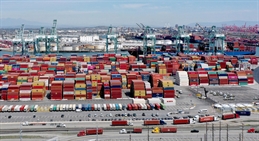
Berthing delays are causing a huge build-up of export containers within port terminals and creating a big spike in container dwell times globally according to data tracked by supply chain visibility data firm, project44.
In a new report, it said export containers at the Port of Los Angeles took an average of 11.85 days to be loaded on a ship between October 2021 and November 2021 while Port of Long Beach took an average of 10.98 days.
"With export containers taking about twice as long to move through US West Coast ports as import containers, the problem appears to be getting containers off of docks and onto ships," project44 added.
It noted that bsed on its data and analysis, long export container dwell times occur when ships berth days after their scheduled berthing times.
Berthing delays cited
While these ships wait at anchor, containers that were delivered on time languish at the docks, waiting for their arrival, it added.
"If a carrier advises its customers to deliver export containers at a certain date and time based on the ETA/berthing schedule of the ship and that ship’s berthing is then delayed, then there will be a build-up of export containers waiting inside the port for the ship," said Josh Brazil, VP of Data Insights at project44.
"This appears to be what’s happening, based on the data we’re seeing. Export containers are subsequently waiting in ports for ships, which are taking longer than expected to arrive."
He added that as of the time of this release, while dozens of container vessels are slow steaming far off the California coast, "we are seeing close to 37 container ships close to shore waiting to berth at these ports and it's these long queues that are pushing up dwell times on export containers."
While vessel traffic data it tracked shows a "drop in waiting" directly outside the ports of Long Beach and Los Angeles in the second half of November, Brazil warns that this drop could be due to the change in the definition of "the waiting zone based on the new berthing queue system implemented by the San Pedro Bay ports."
"The definition of 'berth waiting time' has indeed continually changed throughout this ordeal. For our measurement we’ve used a generous 80 nautical mile (92 miles) radius out from the port on anchored container ships and container ships and with vessels
Increasing container dwell times
The berthing delays however are impacting the container dwell times for export containers globally, project44 said.
For the month of November, the supply chain visibility data firm said export container dwell time has "consistently tracked more than twice the dwell time of import containers."
It said in Los Angeles, on the November 1, the export container dwell times were 11 days, versus 5.04 days for imports. At the end of November, the disparity was even more pronounced, with export containers dwelling 17.49 days versus 6.42 days on imports - more than 2.5 times.
Long Beach, meanwhile, seemed to have outperformed Los Angeles in regards to dwell time according to the analysis, with an export dwell time of 6.83 days and import dwell time of 5.49 days on November 1, but this has increased dramatically to an export dwell time of 15.16 days and an import dwell time of 7.97 days at the end of the same month — which it said has been the highest it has ever been.
Noting that "shipping is a global ecosystem", project44 said while the US port data shows a dramatic increase in the export dwell times, many of the other main ports tracked around the world paints a different picture with South East Asian ports like Singapore and Hong Kong showing marked decreases in export container dwell times.
"This means that at these ports the berthing delays are not as pronounced as it is in the USA where export containers are reaching the ports in time but simply not being able to be loaded on board the intended ships as the ship does not have a berth yet," Brazil said.
On the other hand, he noted that Chinese base ports are showing more or less similar trends in export and import dwell times but with more fluctuations month on month.
Rotterdam, one of the main ports in Europe and Jebel Ali, one of the main ports in the Middle East respectively, "reflected a hybrid situation with export dwell times not as bad as the USA but not as good as the South East Asia/China ports," project44 added.
It noted that Rotterdam had an average of 6.76 days export dwell time and 2.91 days import dwell time across 2021 while Jebel Ali had an average of 6.27 days export dwell time and 3.26 days across 2021.



